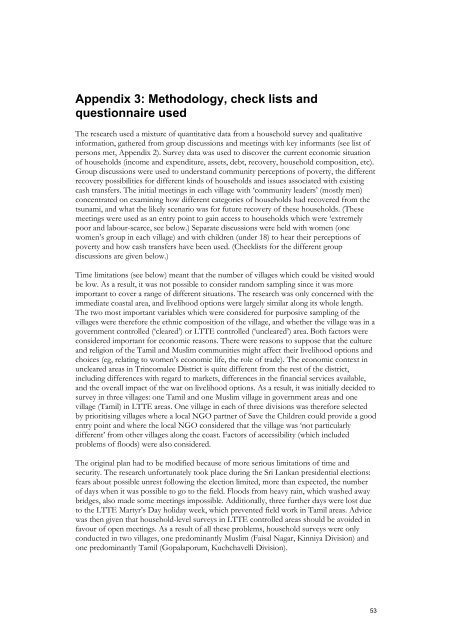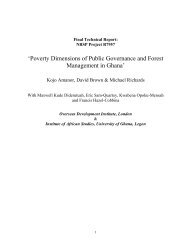Feasibility study on a capital-based income generation scheme for ...
Feasibility study on a capital-based income generation scheme for ...
Feasibility study on a capital-based income generation scheme for ...
You also want an ePaper? Increase the reach of your titles
YUMPU automatically turns print PDFs into web optimized ePapers that Google loves.
Appendix 3: Methodology, check lists and<br />
questi<strong>on</strong>naire used<br />
The research used a mixture of quantitative data from a household survey and qualitative<br />
in<strong>for</strong>mati<strong>on</strong>, gathered from group discussi<strong>on</strong>s and meetings with key in<strong>for</strong>mants (see list of<br />
pers<strong>on</strong>s met, Appendix 2). Survey data was used to discover the current ec<strong>on</strong>omic situati<strong>on</strong><br />
of households (<strong>income</strong> and expenditure, assets, debt, recovery, household compositi<strong>on</strong>, etc).<br />
Group discussi<strong>on</strong>s were used to understand community percepti<strong>on</strong>s of poverty, the different<br />
recovery possibilities <strong>for</strong> different kinds of households and issues associated with existing<br />
cash transfers. The initial meetings in each village with ‘community leaders’ (mostly men)<br />
c<strong>on</strong>centrated <strong>on</strong> examining how different categories of households had recovered from the<br />
tsunami, and what the likely scenario was <strong>for</strong> future recovery of these households. (These<br />
meetings were used as an entry point to gain access to households which were ‘extremely<br />
poor and labour-scarce, see below.) Separate discussi<strong>on</strong>s were held with women (<strong>on</strong>e<br />
women’s group in each village) and with children (under 18) to hear their percepti<strong>on</strong>s of<br />
poverty and how cash transfers have been used. (Checklists <strong>for</strong> the different group<br />
discussi<strong>on</strong>s are given below.)<br />
Time limitati<strong>on</strong>s (see below) meant that the number of villages which could be visited would<br />
be low. As a result, it was not possible to c<strong>on</strong>sider random sampling since it was more<br />
important to cover a range of different situati<strong>on</strong>s. The research was <strong>on</strong>ly c<strong>on</strong>cerned with the<br />
immediate coastal area, and livelihood opti<strong>on</strong>s were largely similar al<strong>on</strong>g its whole length.<br />
The two most important variables which were c<strong>on</strong>sidered <strong>for</strong> purposive sampling of the<br />
villages were there<strong>for</strong>e the ethnic compositi<strong>on</strong> of the village, and whether the village was in a<br />
government c<strong>on</strong>trolled (‘cleared’) or LTTE c<strong>on</strong>trolled (‘uncleared’) area. Both factors were<br />
c<strong>on</strong>sidered important <strong>for</strong> ec<strong>on</strong>omic reas<strong>on</strong>s. There were reas<strong>on</strong>s to suppose that the culture<br />
and religi<strong>on</strong> of the Tamil and Muslim communities might affect their livelihood opti<strong>on</strong>s and<br />
choices (eg, relating to women’s ec<strong>on</strong>omic life, the role of trade). The ec<strong>on</strong>omic c<strong>on</strong>text in<br />
uncleared areas in Trincomalee District is quite different from the rest of the district,<br />
including differences with regard to markets, differences in the financial services available,<br />
and the overall impact of the war <strong>on</strong> livelihood opti<strong>on</strong>s. As a result, it was initially decided to<br />
survey in three villages: <strong>on</strong>e Tamil and <strong>on</strong>e Muslim village in government areas and <strong>on</strong>e<br />
village (Tamil) in LTTE areas. One village in each of three divisi<strong>on</strong>s was there<strong>for</strong>e selected<br />
by prioritising villages where a local NGO partner of Save the Children could provide a good<br />
entry point and where the local NGO c<strong>on</strong>sidered that the village was ‘not particularly<br />
different’ from other villages al<strong>on</strong>g the coast. Factors of accessibility (which included<br />
problems of floods) were also c<strong>on</strong>sidered.<br />
The original plan had to be modified because of more serious limitati<strong>on</strong>s of time and<br />
security. The research un<strong>for</strong>tunately took place during the Sri Lankan presidential electi<strong>on</strong>s:<br />
fears about possible unrest following the electi<strong>on</strong> limited, more than expected, the number<br />
of days when it was possible to go to the field. Floods from heavy rain, which washed away<br />
bridges, also made some meetings impossible. Additi<strong>on</strong>ally, three further days were lost due<br />
to the LTTE Martyr’s Day holiday week, which prevented field work in Tamil areas. Advice<br />
was then given that household-level surveys in LTTE c<strong>on</strong>trolled areas should be avoided in<br />
favour of open meetings. As a result of all these problems, household surveys were <strong>on</strong>ly<br />
c<strong>on</strong>ducted in two villages, <strong>on</strong>e predominantly Muslim (Faisal Nagar, Kinniya Divisi<strong>on</strong>) and<br />
<strong>on</strong>e predominantly Tamil (Gopalaporum, Kuchchavelli Divisi<strong>on</strong>).<br />
53
















